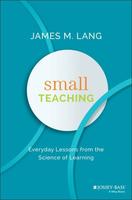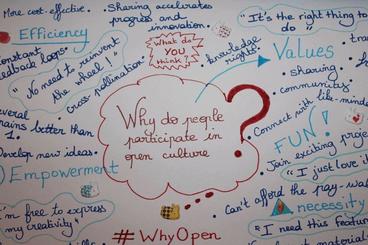
Using Brief Writing Tasks to Deepen Understanding
Congratulations! Week 1 is in the bag. All that remains is the rest of the semester. Take a moment to appreciate all you have already done. You have created and distributed your course syllabus and schedule. In those documents, you have likely provided an overview of the key assignments and assessments you will use to measure student learning. Perhaps you have also indicated ways that students can avail themselves of the rich resources available through Student Writing Support and other campus organizations. You have poured a foundation for your students.

But a foundation is only strong if students are able to build on it. As has been documented in the educational sciences and the biology of learning, comprehension and understanding are a result of the connections learners are able to make among the concepts, facts, and skills they encounter in a course. The denser the connections, the deeper the learning. Drawing on James Lang’s useful and highly readable Small Teaching: Everyday Lessons from the Science of Learning, this post offers three suggestions for integrating in-class writing that fosters connections that can enable deeper understanding for students. These writing tasks are brief enough—or “small enough,” to use Lang’s terminology—not to have required pre-semester planning or documentation in your syllabus. They have the added bonus of being malleable to fit different class sizes and formats.

Suggestion 1: Ask students to fill in a lecture outline
To provide students with full access to course materials, many instructors provide annotated slide decks and lecture notes on Canvas. While students appreciate the instructor’s detailed notes and use them for review, they can potentially limit comprehension for students by denying them the active work of making connections. Rather than giving a detailed copy of lecture notes at the outset, provide students first with an organizational framework or outline for the material—the headings, names of key terms and concepts—and invite students to fill in the information as they read, listen to lecture, participate in discussion, watch videos, etc. Encouraging students to actively encode the connections can be especially effective with conceptual learning, where rote memorization often has little impact (Lang 99).
Example: An instructor in a British Literature course begins the class by providing a skeletal outline that lists a few key terms, titles and dates (Modernism, 1910, To the Lighthouse, stream-of-consciousness, Narrative, “Time Passes”). Students are encouraged to use the list as an organizational framework as the lecture and discussion proceeds.
Suggestion 2: Ask students to visualize connections with concept maps
An abundance of educational software makes it easy for students to create conceptual maps. But whiteboards, poster sheets and markers can work, too. Whether digital or analog, a concept map is “a visual representation of a knowledge domain” (Ambrose et al, cited in Lang 104), one where the relationship between concepts is expressed by creating phrases and images that are linked by branches. As Lang suggests, a particularly effective use of the concept map is to provide students with a focus question (e.g. “What are the positive and negative consequences of violent revolutions?”) and to use the concept map as a way to answer it. Concept maps can be done individually or in groups and then quickly shared in class or electronically.
Example: After a unit on unemployment policy and benefits, an instructor in Applied Economics asks students to make a concept map in response to the question, “Should unemployment benefits be extended beyond six months?”
Suggestion 3: Ask students to write claims that assert or explain a relationship among concepts
In Small Teaching, Lang shares an adaptable, in-class exercise he calls “The Minute Thesis.” Students are given two columns of information and asked to write a thesis statement that asserts a relationship between two items in the first column (in Lang’s case, novels read over the semester) and one item in the second column (course themes). The exercise occurs toward the end of the semester as students are gearing up to write final essays. The thesis statements they draft are not always ones that are developed formally in their papers, but the exercise provides students with a low-risk opportunity to practice making assertions (claims that can be contested), establish conceptual connections, and discuss how those connections might be developed in subsequent writing.

Example: An instructor in Physics wants to make sure her students have a clear grasp of force, the central concept in Newtonian mechanics. She also wants to determine if her students can demonstrate their understanding by explaining the difference between the Newtonian concept and common misunderstandings, as identified in a Force Concept Inventory. On the whiteboard or in an accessible PDF, the instructor writes Column A associated with the Newtonian conception of Kinematics (Velocity discriminated from position; Acceleration discriminated from position; Constant acceleration entails parabolic orbit, changing speed; Vector addition of velocities); in Column B she lists common misunderstandings associated with Kinematics (position-velocity undiscriminated; velocity-acceleration undiscriminated, nonvectorial velocity composition). Students are then asked to write a brief statement that clarifies the difference between one item in Column A and its corresponding misunderstanding in Column B. Students share their responses and discuss in class, providing an opportunity to correct and clarify one another.
Supporting an Accessible Environment
While each of these writing activities has the potential to deepen understanding, students may require various ways to access course materials and participate in class. Instructors should consult the Disability Resource Center for ways to ensure full access for everyone.
Please Share
Have you used in-class writing to foster connections and deepen understanding? If so, please share an effective exercise you have used in the comments section below.
Further Support
See the Teaching with Writing pages on the Center for Writing website for teaching resources. As many of you know, our WAC program also hosts a popular Teaching with Writing series. For more information, visit us online and follow us on Twitter @UMNWriting. If you would like some timely feedback, please schedule a consultation or use our new Writing Assignment Hotline by emailing us ([email protected]) a draft of your assignment with specific questions you would like us to consider.
- Log in to post comments